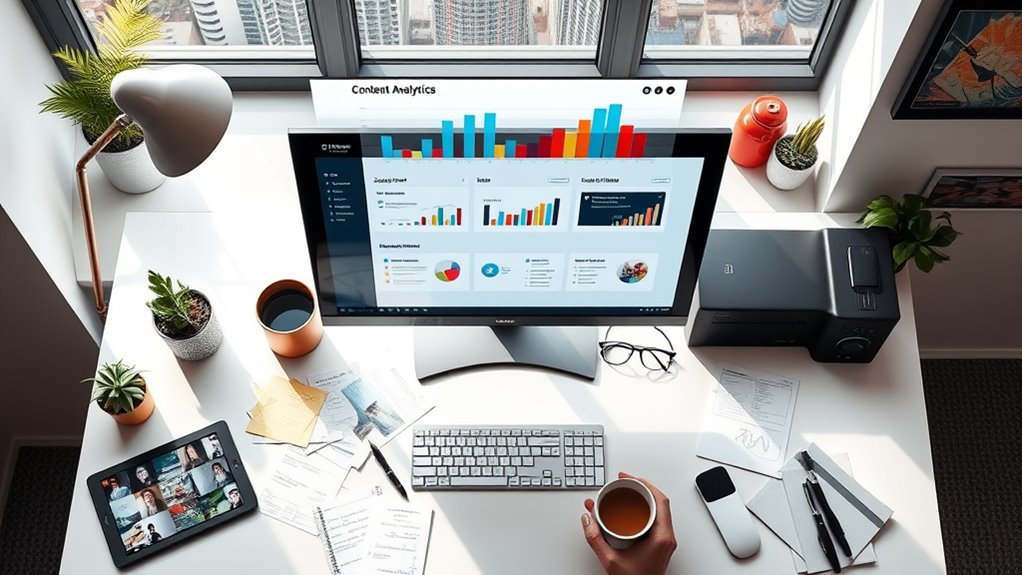To maximize ROI from existing content, focus on strategic repurposing by transforming materials into various formats like social posts, videos, or summaries tailored to specific audience segments. Share content across the channels your audience prefers, timing it for peak engagement. Segment your audience to deliver targeted messages, and analyze what works best for future efforts. Master these tactics, and you’ll see bigger reach and engagement—keep exploring for more key strategies behind successful content repurposing.
Key Takeaways
- Segment your audience to tailor content formats and messaging for higher engagement and relevance.
- Repurpose content into diverse formats like videos, social posts, and newsletters to extend reach across channels.
- Analyze audience preferences and past performance to optimize timing and format for maximum impact.
- Focus on strategic distribution channels that align with audience habits to amplify content effectiveness.
- Continuously refine your approach by leveraging data insights to improve content relevance and ROI.

In today’s fast-paced digital landscape, content repurposing has become a pivotal strategy to maximize your efforts and reach a broader audience. Instead of constantly creating new material from scratch, you can leverage existing content by transforming it into different formats and distributing it strategically. This approach not only saves time but also amplifies your message across multiple channels, helping you connect with diverse segments of your audience more effectively. To do this successfully, you need a solid understanding of content distribution and audience segmentation. These two elements work hand-in-hand to ensure your repurposed content hits the right people at the right time.
Content distribution involves choosing the right platforms and methods to deliver your content. When you repurpose content, it’s essential to think about where your audience spends their time and how they prefer to consume information. For example, a detailed blog post can be turned into bite-sized social media updates or short videos for platforms like Instagram or TikTok. Email newsletters are another valuable channel, allowing you to share summaries or key takeaways from your content with your subscriber base. By diversifying your content distribution, you ensure your message reaches different audience segments, each with their preferred formats and channels.
Choose the right platforms and formats to effectively reach diverse audience segments.
Audience segmentation plays a vital role in maximizing your repurposing efforts. Instead of treating your entire audience as one monolith, you break them into groups based on demographics, interests, behaviors, or engagement levels. This way, you can tailor your repurposed content to meet their unique needs and preferences. For instance, your younger followers might prefer quick, visual content, while your more professional audience might respond better to in-depth articles or webinars. When you combine audience segmentation with strategic content distribution, you create a targeted approach that increases engagement and conversion rates.
Furthermore, understanding audience segmentation helps you identify which content formats work best for each group. You can analyze data from previous campaigns to see what resonated most and then adapt your repurposing strategy accordingly. This iterative process ensures your efforts aren’t wasted on formats or channels that don’t perform well. As you refine your approach, you’ll find that your content’s ROI improves because you’re delivering the right message to the right audience at the right time. Additionally, familiarizing yourself with key retail hours can help you optimize the timing of your content releases for maximum impact.
In essence, mastering content distribution and audience segmentation empowers you to maximize the value of your existing content. You don’t have to reinvent the wheel every time; instead, you adapt and deliver it in ways that resonate with different segments of your audience. This targeted, strategic approach boosts your reach, engagement, and ultimately, your return on investment.
Frequently Asked Questions
How Do I Choose Which Content to Repurpose First?
You should start by conducting a content audit to identify high-performing pieces. Use audience analysis to determine which topics resonate most with your audience. Prioritize repurposing content that already shows engagement and aligns with your target’s interests. Focus on those that can be quickly transformed into different formats, maximizing ROI. This approach guarantees your efforts target content that delivers the most value and audience impact first.
What Tools Are Best for Automating Content Repurposing?
You should consider AI tools and automation platforms like Buffer, Hootsuite, or Lately, which streamline content repurposing. These tools automatically convert blog posts into social media snippets, videos, or emails, saving you time. They handle scheduling, editing, and distribution effortlessly. By leveraging AI-driven automation, you can maximize your content’s reach and ROI without manual effort, making your repurposing strategy more efficient and scalable.
How Can I Measure the Success of Repurposed Content?
You can’t afford to ignore how your repurposed content performs, so measure its success through analytics metrics and audience engagement. Track indicators like page views, shares, comments, and conversion rates to gauge impact. If your audience engages more and your metrics improve, you’re hitting the jackpot. Keep a close eye on these signs to optimize your content strategy and turn your efforts into unstoppable growth.
What Are Common Pitfalls to Avoid in Content Repurposing?
Be cautious of content duplication, which can harm your SEO and confuse your audience. Avoid over-optimization, like keyword stuffing or excessive editing, that can make your content seem unnatural. Focus on maintaining originality and providing value in each repurposed piece. Also, verify you’re adapting content appropriately for different platforms rather than copying it directly. These pitfalls can diminish your content’s effectiveness and ROI.
How Often Should I Update or Refresh Repurposed Content?
You should update or refresh your repurposed content every 3 to 6 months to maintain content freshness and guarantee accuracy. Regular updates keep your content relevant, improve SEO, and engage your audience effectively. Monitor industry changes and analytics to determine if more frequent updates are needed. Staying consistent with update frequency helps you maximize ROI by keeping your content valuable and current, ultimately boosting your overall content strategy.
Conclusion
By mastering content repurposing, you’re revealing a treasure trove of value hiding in your existing assets. With just a few strategic tweaks, you can stretch every piece further than you ever imagined—turning a single blog post into a multi-channel powerhouse. Don’t let your content sit idle; transform it into a marketing juggernaut that crushes your competition. Embrace these tactics today and watch your ROI skyrocket to levels that seem almost too good to be true!









